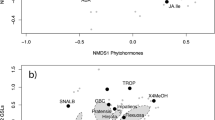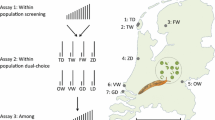Abstract
According to theory, variation in plant secondary metabolism against herbivores is driven by variation in biotic and abiotic conditions interacting with plants genotype to determine the expression of resistance traits. Particularly, it has been long postulated that plants growing along latitudinal gradients experience changes in biotic and abiotic interactions, specifically leading to a decrease of plant toxicity towards the poles. We tested this hypothesis using the asteraceous species Smallanthus macroscyphus. Smallanthus species are known to contain sesquiterpene lactones (STLs), bitter compounds with a broad spectrum of biological activities, including deterrence to herbivores. S. macroscyphus showed a decrease in chemical diversity of STLs when investigating populations growing from the tropical regions to less tropical ones. Populations from lower latitudes were found to be more chemically diverse with enhydrin, uvedalin and fluctuanin as main components, while populations southward were chemically fairly uniform, with polymatin A as the main and largely dominant STL. The STL chemistry of S. macroscyphus is in agreement with the hypothesis that plants of tropical forests have a greater diversity of secondary metabolites when compared to their temperate counterparts.




Similar content being viewed by others
References
Ambrósio SR, Oki Y, Gomes Heleno VC, Siqueira Chaves J, Barboni Dantas Nascimento PG, Espada Lichston J, Gomes Constantino M, Mouro Varanda E, Da Costa FB (2008) Constituents of glandular trichomes of Tithonia diversifolia: relationships to herbivory and antifeedant activity. Phytochemistry 69:2052–2060
Bach S, Schuff C, Grau A, Catalán CAN (2007) Melampolides and other constituents from Smallanthus connatus. Biochem Syst Ecol 35:785–789
Becerra JX (2015) Macroevolutionary and geographical intensification of chemical defense in plants driven by insect herbivore selection pressure. Curr Opin Insect Sci 8:15–21. doi:10.1016/j.cois.2015.01.012
Berenbaum MR, Nitao JK, Zangerl AR (1991) Adaptive significance of furanocoumarin diversity in Pastinaca sativa (Apiaceae). J Chem Ecol 17:207–215
Bolser RC, Hay ME (1996) Are tropical plants better defended? Palatability and defenses of temperate vs. tropical seaweeds. Ecology 77:2269–2286
Brown AD, Grau HR, Malizia LR, Grau A (2001) Argentina. In: Kappelle M, Brown AD (eds) Bosques Nublados del Neotrópico. IMBIO, Costa Rica, pp 623–659
Cabrera A (1976) Regiones Fitogeográficas de la República Argentina. Enciclopedia de Agricultura, Jardinería y Fruticultura 2. Acme, Buenos Aires, pp 1–85
Chow JC, Mullin CA (1993) Distribution and antifeedant associations of sesquiterpene lactones in cultivated sunflower (Helianthus annuus L.) on western corn rootworm (Diabrotica virgifera virgifera LeConte). J Chem Ecol 19:1439–1452
Cis J, Nowak G, Kisiel W (2006) Antifeedant properties and chemotaxonomic implications of sesquiterpene lactones and syringin from Rhaponticum pulchrum. Biochem Syst Ecol 34:862–867
Coley PD, Aide TM (1991) A comparison of herbivory and plant defenses in temperate and tropical broad-leaved forests. In: Price PW, Lewinsohn TM, Fernandes GW, Benson WW (eds) Plant-animal interactions: evolutionary ecology in tropical and temperate regions. Wiley, New York, pp 25–49
Coley PD, Barone JA (1996) Herbivory and plant defenses in tropical forests. Ann Rev Ecol Syst 27:305–335
Coll Aráoz MV, Mercado MI, Grau A, Catalán CA (2007) Lactonas sesquiterpénicas de Smallanthus siegesbeckius (Heliantheae, Asteraceae). Bol Latinoam Caribe Plant Med Aromat 6:187–188
Coll Aráoz MV, Mercado MI, Grau A, Ponessa GI (2008) Morfología y anatomía foliar, caulinar y radicular de Smallanthus macroscyphus (Asteraceae). Lilloa 45:23–33
De la Sota ER (1972) Sinopsis de las Pteridófitas del Noroeste de Argentina. Darwiniana 17:11–103
De Pedro A, Cuenca M, Grau A, Catalan CAN, Gedris TE, Herz W (2003) Melampolides from Smallanthus macroscyphus. Biochem Syst Ecol 31:1067–1071
Duffey SS, Stout MJ (1996) Antinutritive and toxic components of plant defense against insects. Arch Insect Biochem Physiol 32:3–37
Favi F, Cantrell CL, Mebrahtu T, Kraemer ME (2008) Leaf peltate glandular trichomes of Vernonia galamensis ssp. galamensis var. ethiopica Gilbert: development, ultrastructure, and chemical composition. Int J Plant Sci 169:605–614
Grau A, Rea J (1997) Yacon. Smallanthus sonchifolius (Poepp. and Endl.) H. Robinson. In: Hermann M, Heller J (eds) Andean roots and tuberous roots: Ahipa, Arracacha, Maca and Yacon. Promoting the conservation and use of underutilized crops. IPK, Gatersleben/IPGRI, Rome, pp 199–256
Grau A, Zapater MA, Neumann RA (2006) Botánica y Distribución del Género Cedrela en el Noroeste de Argentina. In: Pacheco S, Brown A (eds) Ecología y Producción de Cedro en las Yungas Australes. LIEY- ProYungas, Argentina, pp 19–30
Jones CG, Firn RD (1991) On the evolution of plant secondary chemical diversity. Philos Trans R Soc Lond [Biol] 333:273–280
Lewinsohn TM (1991) The geographical distribution of plant latex. Chemoecol 2:64–68
Mercado MI, Coll Aráoz MV, Grau A, Catalán CAN (2010) New acyclic diterpenic acids from yacon (Smallanthus sonchifolius) leaves. Nat Prod Commun 5:1721–1726
Mercado MI, Coll Araoz MV, Ruiz AI, Grau A, Ponessa GI (2012) Análisis estructural, ultraestructural y desarrollo ontogenético de los tricomas glandulares de Smallanthus sonchifolius (Asteraceae), « yacón». Lilloa 49:40–51
Mercado MI, Coll Araoz MV, Manrique I, Grau A, Catalán CAN (2014) Variability in sesquiterpene lactones from the leaves of yacon (Smallanthus sonchifolius) accessions of different geographic origin. Genet Resour Crop Evol 61:1209–1217
Moles AT, Bonser SP, Poore AGB, Wallis IR, Foley WJ (2011) Assessing the evidence for latitudinal gradients in plant defence and herbivory. Funct Ecol 25:380–388. doi:10.1111/j.1365-2435.2010.01814.x
Morales JM, Sirombra M, Brown AD (1995) Riqueza de árboles en las Yungas argentinas. In: Brown AD, Grau HR (eds) Investigación, conservación y desarrollo en selvas subtropicales de montañas. Laboratorio de Investigaciones Ecológicas de las Yungas (UNT), Tucumán, Argentina, pp 163–174
Navarro FR, Cuezzo F, Goloboff PA, Szumik C, Lizarralde de Grosso M, Quintana MG (2009) Can insect data be used to infer areas of endemism? An example from the Yungas of Argentina. Rev Chil Hist Nat 82:507–522
Pennings SC, Ho C-K, Salgado CS, Wieski K, Davé N, Kunza AE et al (2009) Latitudinal variation in herbivore pressure in Atlantic Coast salt marshes. Ecology 90:183–195
Poore AGB, Campbell AH, Coleman RA, Edgar GJ, Jormalainen V, Reynolds PL et al (2012) Global patterns in the impact of marine herbivores on benthic primary producers. Ecol Lett 15:912–922
Rasmann S, Agrawal AA (2009) Plant defense against herbivory: progress in identifying synergism, redundancy, and antagonism between resistance traits. Curr Opin Plant Biol 12:473–478
Rasmann S, Agrawal AA (2011) Latitudinal patterns in plant defense: evolution of cardenolides, their toxicity and induction following herbivory. Ecol Lett 14:476–483
Salazar D, Marquis RJ (2012) Herbivore pressure increases toward the equator. Proceed Natl Acad Sci USA 109:12616–12620. doi:10.1073/pnas.1202907109
Schemske DW, Mittelbach GG, Cornell HV, Sobel JM, Roy K (2009) Is there a latitudinal gradient in the importance of biotic interactions? Ann Rev Ecol Evol Syst 40:245–269
Seaman FC (1982) Sesquiterpene lactones as taxonomic characters in the Asteraceae. Bot Rev 48:121–594
Serra Barcellona C, Coll Aráoz MV, Cabrera WM, Habib NC, Honoré SM, Catalán CAN, Grau A, Genta SB, Sánchez SS (2014) Smallanthus macroscyphus: a new source of antidiabetic compounds. Chem Biol Interact 209:35–47
Steppuhn A, Baldwin IT (2007) Resistance management in a native plant: nicotine prevents herbivores from compensating for plant protease inhibitors. Ecol Lett 10:499–511
Takasugi M, Masuda T (1996) Studies on stress metabolites. Three 4′-hydroxyacetophenone-related phytoalexins from Polymnia sonchifolia. Phytochemistry 43:1019–1021
Thompson JD (2005) Plant evolution in the Mediterranean, chap 4. Oxford University Press, Oxford, p 293
Acknowledgments
We thank Dr. Sergio Rasmann who made valuable contributions to the first draft, Dr. Gastón Aguilera, who helped with the statistics and the Late Dr. Fernando Navarro who supplied valuable information.
Author information
Authors and Affiliations
Corresponding author
Ethics declarations
Funding
This research was supported by ANPCyT (Grant PICTO 2004-503, PICT 2011-1871), CIUNT A26/403 and CONICET from Argentina. María V. Coll Aráoz and María I. Mercado received research grants from CONICET.
Additional information
Handling Editor: Kerstin Reifenrath.
Electronic supplementary material
Below is the link to the electronic supplementary material.
Rights and permissions
About this article
Cite this article
Coll Aráoz, M.V., Mercado, M.I., Grau, A. et al. Intraspecific variation of sesquiterpene lactones associated to a latitudinal gradient in Smallanthus macroscyphus (Heliantheae: Asteraceae). Chemoecology 26, 143–151 (2016). https://doi.org/10.1007/s00049-016-0213-1
Received:
Accepted:
Published:
Issue Date:
DOI: https://doi.org/10.1007/s00049-016-0213-1




